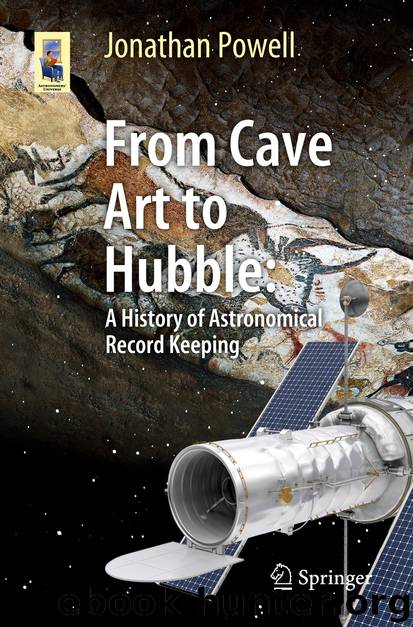From Cave Art to Hubble by Jonathan Powell

Author:Jonathan Powell
Language: eng
Format: epub
ISBN: 9783030316884
Publisher: Springer International Publishing
Observation of the Transit
Practical experience had taught both Horrocks and Crabtree that cosmological truths were not to be found in the tabular computations, but only in the direct observation of the heavens where they could apply measurements firsthand, rather than rely on the invariably indifferent tables of the time. It is considered, by some of the remarks that Crabtree made, that he had the foresight to see this eventuality long before Horrocks, making the realization that this was going to be the premise for any advancement, drawing Horrocks away from a routine that he had apparently fallen into – that of relying on computation work rather than the ‘new’ approach, which was eventually to inspire them to their combined greatest achievement.
Horrocks was well versed in the work on planetary transits by Kepler and Gassendi. A month previously, in October 1639, Horrocks came to the realization that Kepler’s statement, that after the 1631 transit there would not be another transit of Venus until 1761, was wrong. From his own calculations, Horrocks deduced that transits of Venus occur not singly but in pairs 8 years apart. He predicted that as Venus came to inferior conjunction on November 24 it would pass directly in front of the solar disk.
Horrocks , who was known as an assiduous and careful observer, anxious to extend the limits of precision and to seek out and eliminate sources of possible observational error, was convinced that a measurement could be made of the apparent diameter of Venus to within a fraction of a second of an arc when it was seen as a dull black disk on the face of the Sun, compared to an accuracy of around1 min of arc when seen in its normal position as the bright morning “star” close to the Sun. Several weeks before the transit, Horrocks made positional observations of Venus as a morning “star” in readiness for event, eager to have covered as many scientific aspects as possible in preparation.
By telling Crabtree and others (with unfortunately only Crabtree taking any notice before the event), Horrocks had hoped to encourage others to observe so that even if the skies were cloudy for some, a break may be afforded for others, giving the collective number of people involved the best possible chance of the event being observed and documented.
Among those Horrocks attempted to contact were Samuel Foster (died 1652), Professor of Astronomy at Gresham College, London, but to no avail. Correspondence was also sent to his younger brother Jonas, living back at the family home in Toxteth, Liverpool, but again without luck.
On the eve of the event, Horrocks was concerned that the weather would be unfavorable for the transit, as he believed that a rare planetary conjunction would produce severe weather. Despite his clear anxiety over the weather conditions, a concern with which many astronomers can relate, Horrocks was meticulous in his preparation.
On November 23, 1639, from his location in Much Hoole, Horrocks arranged the image projected from his telescope (which had cost half-a-crown)
Download
This site does not store any files on its server. We only index and link to content provided by other sites. Please contact the content providers to delete copyright contents if any and email us, we'll remove relevant links or contents immediately.
| Aeronautics & Astronautics | Astronomy |
| Astrophysics & Space Science | Comets, Meteors & Asteroids |
| Cosmology | Mars |
| Solar System | Star-Gazing |
| Telescopes | UFOs |
Turbulence by E. J. Noyes(7049)
Tools of Titans by Timothy Ferriss(6958)
Astrophysics for People in a Hurry by Neil DeGrasse Tyson(4626)
Room 212 by Kate Stewart(4111)
Pale Blue Dot by Carl Sagan(4014)
The David Icke Guide to the Global Conspiracy (and how to end it) by David Icke(3890)
Secrets of Antigravity Propulsion: Tesla, UFOs, and Classified Aerospace Technology by Ph.D. Paul A. Laviolette(3499)
Apollo 8 by Jeffrey Kluger(3204)
Losing the Nobel Prize by Brian Keating(3188)
A Journey Through Divination and Astronomy by Publishing Pottermore(3132)
Goodbye Paradise(2972)
COSMOS by Carl Sagan(2957)
Brief Answers to the Big Questions by Stephen Hawking(2881)
How to Read Water: Clues and Patterns from Puddles to the Sea (Natural Navigation) by Tristan Gooley(2869)
The Five People You Meet in Heaven by Mitch Albom(2845)
The Order of Time by Carlo Rovelli(2720)
How to Read Nature by Tristan Gooley(2668)
A Brief History of Time by Stephen Hawking(2480)
Aliens by Jim Al-Khalili(2385)
